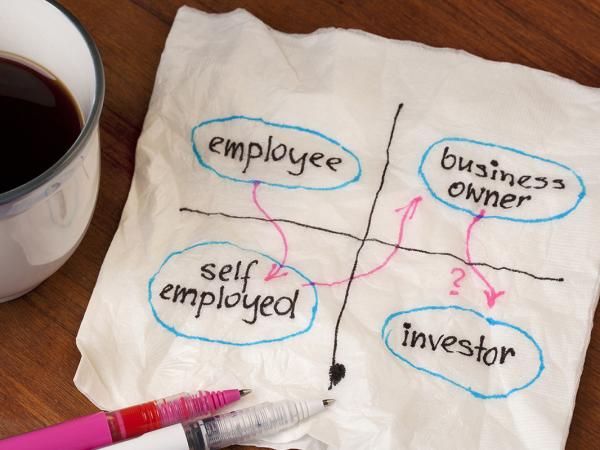Contractors using a limited company
‘Contractors’ are individuals who work through their own limited company to provide their skills and services to other people or businesses. There are some complex rules for contractors to be aware of known as IR35/off-payroll working. These rules help ensure that those who effectively work as employees are taxed as employees, even if they choose to structure their work through a limited company.

Content on this page:
Overview
If your limited company is not supplying goods, but your own services – for instance, you are an IT contractor – then things can get complicated. This is because your company will be a ‘personal service company' and so you will have to consider the impact of the intermediaries legislation (commonly known as IR35/the off payroll working rules).
Please note, these rules are particularly complicated and professional advice would be needed if this applies.
It is important to note that IR35/off payroll working rules only apply where the worker owns more than 5% of the shares in the limited company.
The IR35 rules
Each time you work for a new person/business (called the end client) the IR35 rules require you to look at the working arrangements between you and the end client, ignoring your company. Under IR35, if you would be an employee of the end client you are working for, but for the limited company (and there is a tool on GOV.UK to help you decide this), then your limited company should tell HMRC and potentially pay them some extra tax. This will usually apply in circumstances where you have received dividend income from your company (as well as or instead of wages/salary) - to make up for the fact that they are taxed more favourably than salary. You can find an overview of the IR35 rules on GOV.UK.
The April 2017 changes
HMRC brought in some new rules in April 2017 because they felt that the IR35 rules were not working well. Therefore since April 2017, if a person is working through their own limited company for an end client in the public sector, then they are no longer in charge of deciding if the IR35 rules apply. The decision as to whether the IR35 rules apply now falls to the public body. If they do apply, PAYE tax and NIC must be withheld at source by the public body on any payments to the limited company.
The April 2021 changes
The public sector reforms have been extended to the private sector since April 2021 (delayed from April 2020), but they only affect workers in limited companies that supply their services to medium and large size businesses, that is, those that meet two or more of the following conditions:
- annual turnover of more than £10.2 million,
- a balance sheet total of more than £5.1 million,
- more than 50 employees.
If you provide services to ‘small’ clients in the private sector (as well as individuals, for example, homeowners needing an electrician or gardener) through your own limited company, you will still need to consider whether the original IR35 rules apply to you – these do not just fall away altogether post April 2021.
So you need to make sure you are clear on whether your client is ‘small’ and if so, what the IR35 rules mean for you. GOV.UK guidance for those providing their services to small clients is available here.
Please note that for ease, we tend to think of and refer to the original rules as IR35 and the 2017/2021 rules as off payroll working, although not everybody demarcates them like this.
Off-payroll working rules since 2017 and 2021 in more detail
Basically, these rules say that if you look like an employee for the public sector client or medium/large end client that you work for in the private sector, then you should pay tax like an employee. However, because it is only a ‘deemed’ employment relationship, you will not get any of the employment rights that usually go along with being an employee.
This means that the entity responsible (usually the end client or agency) for paying your company will have to operate PAYE tax and NIC on the amount they pay to your limited company for your services. You can read more about the requirements on ‘fee-payers’ on GOV.UK.
You should then be able to draw out the money from the company as either a salary or dividends without further deductions.
The end client that you work for is responsible for deciding whether you look like an employee (as opposed to a genuinely self-employed person), by applying the general ‘status’ tests. If they are not the entity responsible for paying your limited company they then need to pass the result to them so that PAYE can be operated as appropriate. You can read more about the requirements on end-clients on GOV.UK.
If you are a lower-paid worker, you are not likely to have much autonomy over the work that you do for them, so you will probably be determined to look like an employee.
This is really the key difference between the new rules and the original rules. Under the original IR35 rules, the decision as to whether you look like an employee or not rests with your own limited company, whereas under the new rules, the end client makes the decision instead (with consequences for them if they get things wrong). This makes it much more likely that the rules will be applied properly and that everyone will then pay the correct amount of tax and NIC in accordance with the law.
You can find a summary of the rules as they apply to workers who are providing services to the public sector or medium and large clients in the private sector on GOV.UK. HMRC’s technical guidance can be found here.
As the 2021 off payroll working changes had quite a large impact, there are some extra resources available to help workers understand the 2021 rules, including flowcharts, case studies and factsheets on GOV.UK. Webinars and videos are also available.
If you stop using a limited company
If you fall under the off payroll working rules since 2017/2021, the cost savings you may have received previously may have disappeared. So, working through a limited company becomes much less attractive, especially when you consider all the admin and hassle that usually goes with running a limited company. Indeed, there will be so much potential cost and complexity in supply chains involving limited companies, that if you are a lower paid worker being asked to work through one, you probably need to ask yourself why!
Therefore, you may wish to, or be asked to, stop working through your own limited company. Your options are then to try and get taken on directly by the end client as an employee, or carry on working ‘flexibly’, via agencies for example, but under PAYE. This will usually mean that you will need to work through an umbrella company, as agencies do not usually operate PAYE on workers’ wages themselves.
If you are asked to work through an umbrella company, please be very wary of the potential problems with umbrella companies we outline in our guidance.
If you stop working through your own limited company, you also need to take steps to ensure that your old limited company will be closed down properly.
Managed service companies
In the past, managed service companies (MSCs) have been used to try to help workers avoid reaching the 5% shareholding threshold that brings them potentially within the IR35/off-payroll working rules, while offering, on the face of it, similar advantages to working through a limited company. This is because workers would not own more than 5% of the shares in the MSC.
Broadly this works because workers own shares in a composite company – made up of many, generally unconnected (apart from perhaps being in the same type of trade), non-director shareholders, each holding different classes of share allowing the appropriate amount of income to be channelled to them via a dividend.
It is very complex, but very briefly, the managed service company legislation requires MSCs to apply PAYE to all income earned by individuals operating through MSCs. It does this by deeming any payment or benefit received by a worker through an MSC as earnings from employment. This means it should be subject to tax and NIC at the time the worker receives it. The nature of the relationship between the worker and the end client does not matter in this situation, as it does for IR35/off-payroll working rules.
These rules are also very important to know about if you have worked through an agency or umbrella company where a limited company has been set up for you to work through and where they have helped you run the limited company, for example by deciding a strategy for you on how to be paid from your limited company. This is because they may be an MSC provider, which, means that the limited company you worked through could be an MSC (even if it is not a composite company).
Where HMRC consider that an amount of PAYE is due that has not been paid by the MSC, they can recover it from the worker, even if the worker didn’t fully understand or know about all arrangements in the background. If you get contacted by HMRC about this issue, you should seek professional advice.



